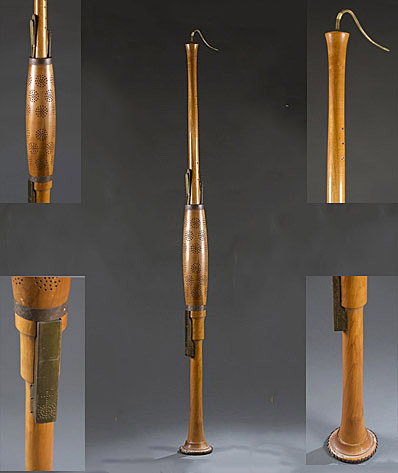
Owner: HWMC
Catalog#: 2CL-AERV-06
Double Reeds - Shawm
Moeck Steinkopf ‘Renaissance Bass Schawm’
Lower Saxony, Germany
Moeck Steinkopf
Maple, brass
ca. 1960’s
Length w/o bocal: 76.5 in, top diameter: 2.75 in, Bell diameter: 6.5 in
Wind Instruments – Woodwind Instruments – Double Reeds – Shawm
Engraved on top section: “Moeck Steinkopf”
The term ‘shawm’ has been used to denote both single-reed and double-reed aerophones. Here we will be referring to the double-reed instruments used extensively in European art music from the 12th century to the 17th century and those experiencing a Renaissance revival in the 20th century.
During the 16th century we know that shawms came in various sizes with the first documented evidence from the Nuremberg woodwind instrument maker Sigmund Schnitzer the elder in 1539. He indicated that shawms were made in five different sizes ranging from sopranino to double bass.. The higher-pitched instruments retained their name, ‘shawm’, however, the term ‘bombarde’ or ‘bumbard’, a term from a medieval artillery piece, was sometimes used in reference to these larger lower-pitched bass shawms. This is a reproduction bass (‘bombarde’) shawm.
It has six finger holes (four have double holes) as well as two sets of yellow brass keys connected to the fontanelle (covering), which adjust the keys on the inside of the instrument. There is a large section in the middle for sound holes arranged in circular shapes, and the segments above and below this section are much thinner in diameter. This instrument has an original bocal and metal rings around the sound hole section with decorative/protective plating around the bell which are all made of yellow brass. There is a metal sound hole box on the lower section of the instrument as well. The instrument is made of a light carved maple wood, and on the top section, the maker’s mark “Moeck Steinkopf” is visible.
In the 1930’s, the Moeck company was started in Celle, in Lower Saxony, Germany, by Hermann Moeck, Sr. His focus was on the production of recorders. As a result of increasing interest during the 20th century, in historical performance on reconstructed wind instruments from the Baroque and Renaissance eras (initiated by Otto Steinkopf), they began to research historical wind instruments including crumhorns, cornamuses, (Kortholte), shawns and pommers, dulcians, racketts, historical cornets, Renaissance and Baroque flutes, oboes, bassoons and early clarinets. By the 1960’s, the production of high-quality copies of selected museum instruments began. Nevertheless, few were made based upon demand. The development of the simple recorder to a more sophisticated instrument was and continues to be their focus today.
